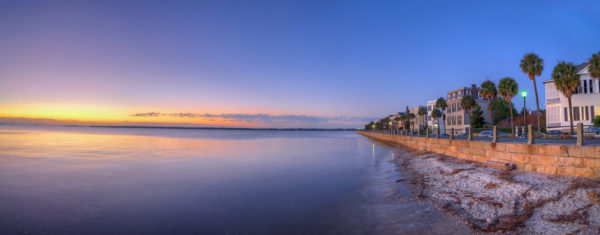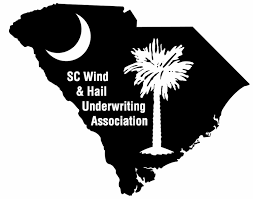Coastal South Carolina Home Insurance Rates

South Carolina has plenty of coastline that is prone to wind, hurricanes, hailstorms, and flooding. Coastal Charleston, South Carolina
South Carolina is an amazing place to call home. It is overflowing with world-class cities, beautiful beaches, museums, and restaurants. It is truly a wonderful place to live.
Unfortunately, some of our beautiful coastal cities, Myrtle Beach, Charleston and Hilton Head as an example come with some pretty high homeowners insurance premiums if you live near the water.
In general, homeowners insurance in South Carolina is a bit more expensive than the average in the U.S. but still very affordable. The average annual premium for homeowners coverage in South Carolina is $1,214 while the countrywide average in the U.S. is $1,034.
However, if you fall into a high-risk zone, your insurance costs could go up dramatically. Parts of Beaufort County, Colleton, Charleston, and Georgetown County are just a few locations where insurance premiums can be much higher.
Here is a quick look at what you need to know about coastal insurance in South Carolina.
High Risk Areas
South Carolina has plenty of coastline that is prone to wind, hurricanes, hailstorms, and flooding. These types of storms can cause serious damage to homes over a very short period of time.
Hurricane Florence, which recently rolled through both South and North Carolina did an estimated $17 to $22 billion in damage and that number may still climb higher. Hurricane Hugo hit South Carolina in 1989 and is still considered one of the most expensive hurricanes in U.S. history, causing roughly $7.3 billion (in 2016 dollars) in damage. South Carolina has been hit by three of the costliest hurricanes to make landfall in the U.S.
While living on the coast leaves you exposed to storm damage, that hasn’t stopped people from moving to these beautiful coastal towns. According to AIR Worldwide, the insured value of coastal properties in South Carolina hit $239 billion in 2015, this accounts for almost 26 percent of the total insured property in the state.
While it is often possible to get a private insurance policy on the coast, there are areas where it can be difficult. Some insurers have excluded wind and hail damage and require a separate wind damage policy. Exclusions vary by insurer so check with your insurance company to make sure you fully covered. You don’t want to find out you are not covered after a major storm hits.

South Carolina Wind and Hail Underwriting Association
While private insurance options have increased in the last few years, South Carolina (like many coastal states) has a state run insurer of last resort. The South Carolina Wind and Hail Underwriting Association (SCWHUA), which is also known as the Beach Plan or Wind Pool, is the insurance market of last resort for South Carolina homeowners. It helps homeowners insure coastal homes when they cannot find coverage in the private market.
What Does a Wind and Hail Policy Cover?
If your standard homeowner policy excludes wind and hail damage you may need to consider a separate windstorm policy or add a windstorm rider to your policy.
Windstorm insurance will cover damage that is caused by high winds or hail. These policies usually kick in when damage is caused by hurricane force winds, severe hail, hurricanes, tornadoes or any storm where the wind gusts over 35 miles per hour.
Windstorm coverage will cover your home and personal property that are damaged due to wind or hail. In most cases, detached structures such as garages, sheds, and swimming pools are also protected by a windstorm policy.
However, like a standard homeowners policy, a windstorm policy does not cover damage that has been caused by flooding or storm surge. You will need a separate flood insurance policy for this type of damage to be covered.
In South Carolina, you may be able to find a windstorm policy in the private market but if this proves to be impossible you should be able to obtain coverage through the SCWHUA. In most cases, these policies will be more expensive than private market insurance.
The South Carolina Wind and Hail Underwriting Association
The SCWHUA was started in 1971 because coastal homeowners were unable to find homeowners insurance in the private market. It is an association of insurance companies that write wind and hail policies in coastal areas where it is difficult to find coverage.
All property and casualty insurance companies that write policies in the state are required to participate in funding the plan and they share all losses and profits.
As of 2017, the Wind Plan had a total of 30,916 policies in force, which was an increase from 29,833 policies in 2016. The Wind Plan had a total exposure of $7.8 billion in fiscal year 2017.
The majority of homeowners can purchase a wind and hail policy from the SCWHUA provided they live in a covered area. It should be noted that the SCWHUA should be considered the insurer of last resort. If a private policy is available in your area it will most likely provide better coverage at a lower price. Always shop around before committing to a SCWHUA policy.
Wind Plan policies do come with restrictions. According to the SCWHUA website, the following restrictions apply to their policies:
- The Association offers a limited peril policy protecting against losses arising out of wind and hail damage. Replacement cost coverage is only available for single-family dwellings built after 1950. It must be a primary residence. A flood policy must be in force at time of loss or the claim will be handled on an Actual Cash Value (ACV) basis.
- The Association will write policies up to $1.3 million of protection for structure, contents, loss of use, increased cost of construction for personal risks such as dwellings, mobile homes, and condominium units. Commercial risks can be insured up to $2.5 million for structure, contents, loss of business income.
- All policies are written for one year only. Continuation of coverage requires the submission of a new application and payment of premium annually.
In addition, the following restrictions also apply.
- The property must not be over water.
- The property, especially the roof, must be in good condition.
- The property must not be used for any illegal or immoral purpose.
- The property must be in the statutorily defined coastal territory.
All properties will be inspected before a policy is issued and they must fall into covered areas. For purposes of coverage, there are two defined Zones in South Carolina.
According to the SCWHUA Website Zone 1 includes:
- All areas in Beaufort County east of the west bank of the Intracoastal Waterway with the exception of Lady’s Island, Coosaw Island, and Morgan Island.
- All areas of Colleton County which are east of the west bank of the Intracoastal Waterway.
- The following areas in Charleston County: the portion of Edisto Island which is east of Peters Point Road and Point of Pines Road, Edingsville Beach, Kiawah Island, Botany Bay Island, Folly Island, Seabrook Island, Morris Island, and all areas north of the city of Charleston which are east of the west bank of the Intracoastal Waterway.
- The following areas in Georgetown County: all areas between the Harrell Siau Bridge and the Georgetown – Horry County border which are east of U.S. Highway No. 17 or By-Pass 17, whichever is further west, and all areas south of the Harrell Siau Bridge which are east of the west bank of the Intracoastal Waterway.
The following areas in Horry County:
- Beginning at the northern border of Horry County, all areas east of the west bank of the Intracoastal Waterway to the point where the where U.S. Highway 17 crosses the Intracoastal Waterway
- From the point where U.S. Highway 17 crosses the Intracoastal Waterway, south to the Georgetown – Horry County border, all areas which are east of U.S. Highway 17 or By-Pass 17, whichever is farther west.
Zone 2 includes:
- The following areas in Beaufort County: Lady’s Island, Coosaw Island, and Morgan Island.
- The following areas in Charleston County:
-
- the portion of Edisto Island which is west of Peters Point Rd and Point of Pines Rd.
- the portion of James Island which is east of the west bank of the James Island Creek.
- the portion of John’s Island which is east of Exchange Road which becomes Plow Ground Road to Hoopstick Island Road to Church Creek.
- the portion of Wadmalaw Island which is east of Roseville Road to west of Cherry Point Road to Maybank Highway to Brigger Hill Road.
- all areas north of the City of Charleston which are east of U.S. Highway 17 and west of the Intracoastal Waterway.
- The following areas in Georgetown County:
-
- all areas between the Harrell Siau Bridge and the Georgetown – Horry County border which are east of the west bank of the Intracoastal Waterway and west of U.S. Highway 17 or By-Pass 17, whichever is farther west.
- all areas south of the Harrell Siau Bridge which are east of U.S. Highway 17 and west of the Intracoastal Waterway
- The following areas in Horry County:
-
- beginning at the northern border of Horry County, an area bounded on the west by a line defined as follows: SC Highway 57 (Wampee Road) to the point where it meets SC Highway 9, then following SC Highway 9 east to SC Highway 31 (Carolina Bays Parkway), then following SC 31 west to River Oaks Drive, then following River Oaks Drive to US Highway 501, across US Highway 501, where the road becomes George Bishop Parkway, then following George Bishop Parkway and turning right onto Claypond Road, following Claypond Road to Burcale Road, then following Burcale Road until it ends at Riverside Drive. The line then continues in a straight line from the end of Burcale Road to the Intracoastal Waterway, where it then follows the waterway to the Georgetown – Horry County border.
- the eastern boundary of Zone 2 in Horry County is the western boundary of Horry County Zone 1 as defined above.
Deductibles Can Be Large
Windstorm policies almost always have a different deductible than a normal insurance policy and policies issued by the SCWHUA are no exception.
Policies that fall into Zone 2 come with a 2 percent deductible that applies to both the structure and your contents. In zone 1, the deductible is 3 percent. These deductibles are based on policy limits.
All of this means that your out of pocket costs will be dramatically higher than with a standard homeowner policy.
As an example, if you have $300,000 in home insurance in Zone 2 your out of pocket costs for a claim will be $6,000 and in Zone 1 you will be looking at $9,000. These numbers can go up dramatically depending on your coverage levels. The deductible on a $700,000 policy in Zone 1 is a whopping $21,000.
These deductibles only apply to Wind Pool policies, private market policies will almost surely come with a percentage deductible but it can vary by insurer. As with all insurance policies read the policy in full and ask questions about anything you do not understand.
